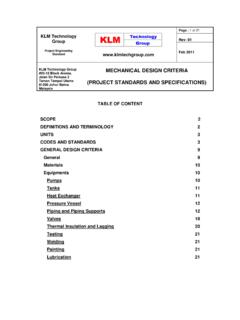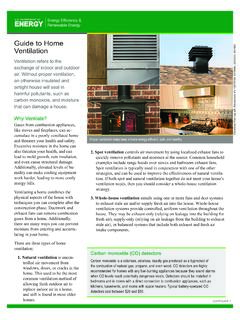Transcription of Quick Start Guide: Rosemount™ DP Level Transmitters and ...
1 Quick Start Guide00825-0100-4016, Rev CBMarch 2017 Rosemount DP Level Transmitters and 1199 Diaphragm seal Page 1 Friday, March 17, 2017 9:46 AMMarch 20172 Quick Start GuideNOTICEThis guide provides basic guidelines for the Rosemount DP Level Transmitters and 1199 Diaphragm seal Systems Reference Manual. It does not provide instructions for configuration, diagnostics, maintenance, service, or troubleshooting. Refer to the appropriate reference manual for more instruction. This guide are also available electronically on products described in this document are NOT designed for nuclear-qualified applications. Using non-nuclear qualified products in applications that require nuclear-qualified hardware or products may cause inaccurate information on Rosemount nuclear-qualified products, contact your local Emerson Sales Introduction.
2 3 Preface .. 3 General handling overview .. 4 mechanical installation .. 4 Ranging the transmitter .. 9 Rosemount 1199 seal types .. Page 2 Friday, March 17, 2017 9:46 AMQuick Start Guide3 March remote seal system consists of a pressure transmitter, a remote seal , and either a direct mount or capillary style connection filled with a secondary fill fluid. During operation, the thin, flexible diaphragm and fill fluid separate the pressure sensor of the transmitter from the process medium. The capillary tubing or direct mount flange connects the diaphragm to the transmitter. When process pressure is applied, the diaphragm is displaced, transferring the measured pressure through the filled system, by way of the capillary tubing, to the transmitter.
3 This transferred pressure displaces the sensing diaphragm in the pressure sensor of the transmitter. This displacement is proportional to the process pressure and is converted electronically to an appropriate output current and/or digital 1. Path of Pressure in a Standard DP Level seal SystemA. PressureB. Process isolating diaphragmC. Transmitter diaphragmD. Fill fluidE. Transmitter pressure guide is designed to assist with general handling and installation instructions for the Rosemount DP Level Transmitters and 1199 Diaphragm seal Systems. The Rosemount DP Level Transmitters and 1199 Diaphragm seal Systems Reference Manual contains supplemental information about the seal system assemblies that are not covered in the corresponding transmitter manuals.
4 Page 3 Friday, March 17, 2017 9:46 AMMarch 20174 Quick Start handling overviewCheck if equipment received conforms to the order. If any issues, contact your local Emerson sales representative unpacking or handling seal system assemblies, do not lift the seal or transmitter by gripping the capillaries, doing so could result in disconnecting the seal and/or capillary from the transmitter, which will void the warranty. The material of a remote seal is designed to withstand pressure and wear from process material, but outside of process connection conditions, remote seals are delicate and should be handled with protective cover should remain on the seal until the moment before installation. Try to avoid touching the diaphragm with fingers or objects and refrain from setting the diaphragm side of the seal down on a hard surface.
5 Even minor dents or scratches in the diaphragm material may impair the performance of the seal system sharply bending or crimping the capillary tubing. The minimum bending radius of the capillary tubing is 3-in. (8 cm).When using heat or steam tracing, exercise caution if PVC coating is added onto capillary. The PVC coating on the armor will break down at temperatures around 212 F (100 C). Best practice for heat and steam tracing is to regulate the temperature above the maximum ambient temperature for a consistent result. To avoid accuracy effects and thermal stress, the capillary should not be partially installation the seal system in vacuum applicationsMounting the pressure transmitter at or below the bottom vessel tap is an important factor to ensure a stable measurement with vacuum applications.
6 The static pressure limit for a differential pressure transmitter is psia (25 mmHgA), which ensures the transmitter sensor module fill fluid remains within the liquid phase of the vapor pressure curve. If the vessel static limit is below psia, mounting the transmitter below the bottom tap provides a capillary fill fluid head pressure on the module. A general rule in vacuum applications is to mount the transmitter approximately 3 ft. (1 m) below the bottom tap of the are to be securely fastened in order to avoid false readings. NOTICEN ever attempt to disconnect the seals or capillaries from the transmitter or loosen bolts. Doing so will result in loss of fill fluid and will void the product Page 4 Friday, March 17, 2017 9:46 AMQuick Start Guide5 March considerations with a Thermal Range Expander seal systemThe Thermal Range Expander System uses the heat from the process in order to keep both fluids within the system functioning properly, therefore insulation is not always required.
7 However, it is always best practice to insulate systems to keep them functioning with optimum performance. The Thermal Range Expander should never be insulated above the line marked on the seal itself, see the figure below for 2. Thermal Range Expander System Insulation type sealsGasketsWhen installing remote seal systems which employ a gasket or a gasket and flushing connection ring, make sure the gasket is aligned properly on the gasket sealing surface. Failure to properly install the gasket may cause process leaks, which can result in death or serious injury. In addition, make sure the gasket does not press down upon the diaphragm face. Anything pressing on the diaphragm will be read by the transmitter as pressure. A misaligned gasket may cause a false reading or damage the diaphragm.
8 The diaphragm gasket is supplied when a lower housing or flushing connection is provided. The default gaskets are listed below, based on seal type. The process gasket must be supplied by the end user. Tantalum diaphragms are not supplied with default gasket, so a gasket option must be selected when Page 5 Friday, March 17, 2017 9:46 AMMarch 20176 Quick Start GuideTable 1. Gasket MaterialsSeal typeGasketsFlanged seals assembliesFFWT hermo-Tork TN-9000 RFWK linger C-4401 EFWNo gasket is suppliedPFWT hermo-Tork TN-9000 FCWNo gasket is suppliedRCWK linger C-4401 FUW/FVWNo gasket is suppliedThreaded seal assembliesRTWK linger C-4401 HTSNo gasket is suppliedHygienic seal assembliesSCW(1)1. Ensure to use EHEDG approved gasket for EHEDG gasket is suppliedSSWE thylene propylene O-ringSTWE thylene propylene O-ringEESNo gasket is suppliedVCS(1)No gasket is suppliedSVS(1)No gasket is suppliedSHPNo gasket is suppliedSLS(1)No gasket is suppliedMLS(1)No gasket is suppliedSpecialty sealsWSPK linger C-4401 UCPB arium-Sulfate filled PTFE O-ringCTWNo gasket is suppliedTFWNo gasket is suppliedWFWK linger Page 6 Friday, March 17, 2017 9:46 AMQuick Start Guide7 March 2017 Maximum working pressure (MWP)Verify the MWP as marked on the transmitter neck label meets or exceeds the expected maximum process pressure the transmitter/ seal assembly could experience once installed.
9 If a flushing ring is used, its MWP should also be torquingWhen connecting the process and mating flange, the bolts should be torqued to the applicable flange requirements. Required torque is a function of the gasket material and surface treatment of the bolts and nuts which are customer type seal optionsCapillary support tubeA common option for the pancake type seal (PFW) is the capillary support tube. Due to the side capillary-to- seal connection, the support tube provides a handle for aligning the pancake seal during installation. The support tube should not be used for supporting any weight above that of the remote flangeEmerson offers the option of supplying the process flange, otherwise the process flange is furnished by the customer. For certain pancake seal assemblies, the Emerson supplied process flange has a machined hole through the center of the flange.
10 This hole corresponds to a threaded connection in the back of the pancake seal upper housing. The flange can, therefore be connected to the seal prior to installation to make handling type sealsLower housing installation procedureThe lower housing of the remote seal has either a male or female thread connection for attachment to a process pipe nipple. When threading the lower housing to the process pipe, care should be taken not to overtighten. The applied torque should comply to ANSI for NPT connections or applicable torque requirements for pipe housing installation procedureThe threaded seal is supplied with carbon steel, bolts, and nuts. 304 SST or 316 SST bolts and nuts can be ordered as options. The torque specifications for the RTW seal can be found in the table installationThreaded seals with flushing connection rings come with a sealing gasket.



















